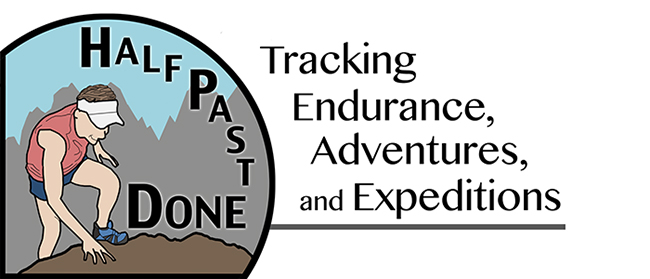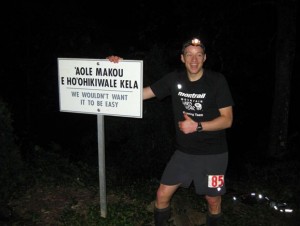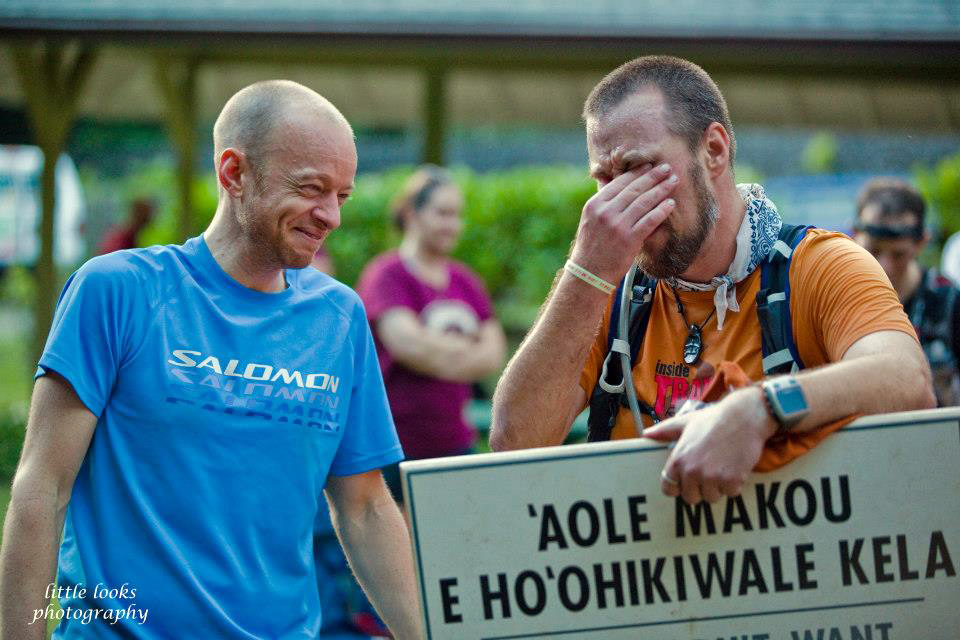
Gary Robbins, left, shares an emotional moment with HURT 100 runner Ken Michal minutes after Michal finished the hundred-miler for the first time after four attempts. Photo courtesy Chuck Little of Little Looks Photography.
In early 2010, Gary Robbins of Vancouver, British Columbia, was an up-and-coming force in North American ultrarunning, surprising many by coming out of seemingly nowhere to break a stout course record at the HURT 100, a gruelingly technical and steep hundred-mile race in Oahu, Hawaii. Robbins was relatively new to the sport, having never run more than a hundred training miles in a week before 2009 or a hundred miles in his life before 2004. But his wins were beginning to stack up, and his victory at HURT showed promise that 2010 would be his breakthrough year. He finished sixth in the Western States 100, and established a fastest known time on Canada’s West Coast Trail.
Then, in October 2010, he broke his foot during a training run. X-Rays confirmed a Jones fracture, a break of the fifth metatarsal bone that is notoriously difficult to heal. After five months of often painful recovery, Robbins was back on his feet and slowly working his way back into running. Then in May 2011, while vacationing in Hawaii, he was out for a solo run when he heard a sickening crack and felt the familiar pain all over again. The second fracture and long recovery left Robbins questioning whether he would ever return to running, let alone competition. But slowly he worked his way back onto the trails and then back into the spotlight.
Earlier this month, Robbins experienced an ultrarunning breakthrough all over again at the HURT 100, winning the race and shattering his own course record in 19 hours and 35 minutes. The following is an interview with Robbins, reflecting on his race and his plans for the upcoming year:
HPD: How do you feel about your performance in the HURT 100? Clearly winning the race with a new course record is a big deal, but did the race go perfectly for you? Did you have a specific plan that you were able to execute? Did you have any times during the race when you thought it might not work out? Any low points?
Robbins: Winning and setting a new course record is certainly about as good as it gets. Compound that with the full story that goes back to me breaking my foot for the second time while I was on vacation and running over those exact HURT course trails, and it gets all that much sweeter.
The race really couldn’t have gone any better. Of course I had a plan in place, but very early on it became evident that other runners weren’t willing to set their own pace. After an interesting leap frog style first lap that felt much like an indoor cycling track event (where riders constantly stall and force their competitors to pass for better position while following), we finally settled into what seemed to be our own individual rhythms for lap two.
By about mile 26 it was shaping up to be a race between myself and fellow Canadian runner Jason Loutitt. Jason had won HURT the previous two years that I’d been sidelined, and he is without a doubt one of Canada’s top ultra distance trail runners.
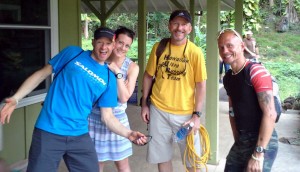
Gary Robbins with his fiancee Linda Barton, as well Bob McAllaster and Jason Loutitt at the HURT 100 pre-race meeting. Photo by Wily Woo.
My pre-race plan was to hang back and run my own race for the first eighty miles before hopefully staying strong enough to move into the lead over the final loop. In the end I was locked in battle with Jason and overall just feeling like all the heavy training I’d recently put in had me at a place with my fitness that I’d never been before. I felt light and fast throughout.
The race director, John Salmonson, thought for sure we’d all gone out too fast on the first twenty-mile loop, but after sixty miles I had averaged 3:40 loops, which was my first loop time in 2010. By mile forty, I knew the course record was going down. Tracking back to my own 2010 effort of 20 hours and 12 minutes, I had dreamed for three full years of being the first person to run sub-20 hours over the HURT course.
It was a slightly unusual race in the fact that I didn’t really suffer many lows at all. I was constantly working hard and racing strong, but I think that after being away from hundred-milers for a full two and a half years, and having such a lengthy journey back to fitness, that I was just running on a bit of cloud nine the entire time. Throw in the fact that I recently got engaged, and that I just joined Team Salomon, and there just seemed to be too many positive things going on around me to allow for any mentally challenging low points to creep in during the run.
Getting back to my overall strategy: it was basically to run consistent, to stay as strong on lap five as I was on lap one. To basically ensure that there aren’t any wild swings in my effort, my focus, and hence my lap times. I knew from past experience that I could stay strong right through the final twenty miles. As I had been hoping for, I started to distance myself from Jason and the other competitors around mile 73. Up until that point we were only ever separated by a few minutes, and though we seldom ran together we were both keeping pressure on each other the entire time.
Coming in off lap four and heading out onto lap five I had my fastest transition of the race, about 45 seconds. I knew that if I got far enough out of sight before any other runners arrived, that the race would effectively be over. At mile 73, I had only a six-minute lead. The next update I got was at mile 86, and I was informed that I had almost an hour. I was finally able to relax mentally for about 45 minutes before I decided that I wanted to ensure that the new course record was as far under twenty hours as possible. I closed out my final lap in four hours and 31 minutes, which was an identical split to my final loop in 2010.
If I’m not mistaken my lap times were:
3h26m
3h37m
3h59m
4h02m
4h31m
HPD: Can you tell me a little bit about the dynamics of the race? What was the competition like up front?
Robbins: For the first twenty miles there were three of us, Nick Hollon, Jason Loutitt and myself. After the first lap it quickly came down to Jason and myself, though through the first sixty miles Leigh Schmidt seemed to be hanging back running smarter than anyone else. I thought he might be waiting to swoop in and pick up the pieces, though after the race I heard he faced some low points and had to rally after the third loop.
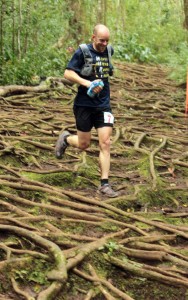
Gary Robbins runs the Pauoa Flats Trail during the HURT 100. Photo by Rob Lahoe.
Jason and I displayed very different skill sets, he the climber verses me the descender, and though we always seemed to be right on top of each other in the aid stations, we rarely saw each other out on the course itself.
I remember constantly arriving at aid stations in advance of Jason and thinking, hoping that I’d put some time on him, only to find that he was inevitably right behind me. We seemed to be jousting without ever making actual contact. It made for a very interesting mental dynamic to the race for sure.
HPD: Can you tell me a little bit about your training in the last few weeks leading up to the HURT 100? What kind of runs did you do, how many kilometers did you put in, how were you feeling, etc.?
Robbins: In the month of December, I had the biggest mileage month of my life at 730 kilometers. In the final nine days of that month, from Christmas Eve through New Year’s Day, I ran 300 kilometers.
During that time frame I raced two 50-kilometer races. At Deception Pass in Washington, I won and set the course record. Though it is only a second-year event they have had a pretty decent contingent of runners in that time and it allowed me to validate that run in my own head. It was the first race I had won in 32 months. I knew I was at a new place with my fitness during that race as I didn’t face any low points during the run and I kept my foot on the gas for the full 3 hours and 57 minutes.
The second 50-kilometer race was on New Years Day, an annual event that I’ve done since 2005. While sidelined in 2010, I actually showed up on did ten kilometers on my crutches, in one hour and 28 minutes. In 2011, as I was fresh off of crutches for the second time, I was only allowed to run ten kilometers. My fastest time over that course coincided with my 2010 HURT victory, so it was a good marker of my fitness. I finished third in 3 hours 47 minutes this year, a thirteen-minute PR. I knew then, at the culmination of my 300-kilometer, nine-day effort, and 730-kilometer month, that the only thing that should stop me from running near the front of HURT on lap number five would be my own race day decisions.
In terms of the types of runs, Vancouver had an unseasonably low snowline in early December, and this forced me to scope out some new, lower running routes, while donning snowshoes and/or microspikes for my higher runs. I put in a decent amount of vertical in December, but looking back on it it wasn’t nearly as much as I was hoping for. I compensated for the lower vertical totals with higher mileage totals. This is not to say that I didn’t spend lots of time on steep terrain, just that minus the snow I would have utilized my terrain in a different manor.
HPD: Do you feel any residual effects or pain from your longterm foot injury? If so, how do you deal with these issues?
Robbins: Absolutely none. I have had zero foot issues now for the better part of eight months.
HPD: In your opinion, what was the single best moment in the 2013 HURT 100?
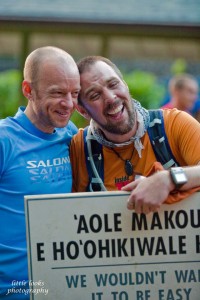
Gary Robbins celebrates with Ken Michal after Michal finished. Photo courtesy of Chuck Little, Little Looks Photography.
I’m a sucker for a feel good story, and in line with that it was the second to last finisher Ken Michal who stole the show. In his fourth attempt at the hundred-miler, and really having not come all too close to the full finish previously, he charged across that finish line in 35 hours and 44 minutes and just absolutely burst open with emotion. I don’t know that anyone had a dry eye and there were probably fifty people around to cheer him in at that point. Ken managed to lose forty pounds since March and few people had a longer and more fruitful journey to a HURT finish than he. It really was the definition of perseverance and proof that if you work hard enough you really can accomplish incredible things.
HPD: Will you be back?
Robbins: I can’t imagine not attending HURT every January. I’ve been at every race since first setting foot there in 2010. In the two years I was forced to the sidelines, I got to know the local HURT community like I never would have had I been able to continually race. It was a bit of a blessing in disguise, I guess. I will most certainly race HURT again, hopefully numerous times. As of right now though, I am intending to return in 2014 and to volunteer again. I have up until their lottery in July to change my mind.
HPD: What races will you be running in 2013? Which ones do you consider your focus races, and what do you hope to accomplish?
Robbins: My year is summed up in twelve letters: HURT, UTMF, and UTMB. Outside of that I’ve signed up for Chuckanut, Diez Vista, and Sinister 7. I’d also like to attempt Fastest Known Times on the Wonderland Trail and the West Coast Trail.
My only focus is the three big races, and I won’t sacrifice a single day of preparation and training for anything else. Right now I am looking at racing Chuckanut and Diez Vista during ninety-mile training weeks, which is exactly what I did at Deception Pass. Sinister 7 was a backup plan in case I didn’t get into UTMB and right now it’s 50/50 as to if I’ll make it there in July.
My goals for UTMF (Ultra Trail Mount Fuji) and UTMB (Ultra Trail Mont Blanc) is to be as competitive as I can come race day. I’d love to podium at these races but the fields will be strong and they will be the biggest tests I’ve faced in many, many years. A top ten finish at UTMB is basically a podium, and I’ve dreamed of that for four years now.
More than anything, I’m just happy to finally be back doing what I love to do again, which is to run through the mountains all day and night long. My longest term goal is of course to stay healthy and to hopefully learn from my mistakes and misfortunes along the way.
